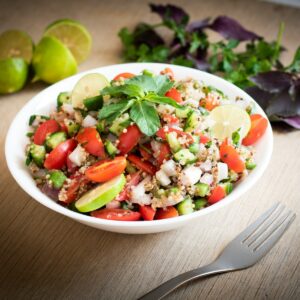In this post, I want to address is the question of consulting with a dietitian or nutritionist in your fitness journey. We will talk about the difference between the two and why it matters. But first, what are the benefits of having professional nutrition advice? What are the considerations in choosing someone to work with?
A fool for a client
There’s a famous saying, a lawyer who represents himself has a fool for a client. This is rooted in the lack of objectivity required to assess your own situation. The same principle applies to nutrition, arguably – unless you do have the credentials and training, it’s very easy to get wrapped up in “bro science” and misguided advice from trainers and even doctors that do not specialize in food. It’s like a cardiologist telling you what kind of adult acne treatment works best. This is a specialized field where the professionals dedicate their lives to helping their clients navigate the impossible grey area of food and body science. That’s layered into the psychological component of the relationship we have with our bodies, ourselves, and food.
My experience with dietitians
Throughout my life, I have probably seen about half a dozen dietitians and nutritionists. I have seen dietitians specializing in body image issues, nutritionists specializing in fertility diets, and nutritionists referred to me by trainers for competitive figure training. Through the journey of this blog, I realized I hadn’t seen any kind of food professional in at least a year, and that was a different time in my life when I had different goals. At this point, my food approach was almost a mishmash of all the previous advice I had been given, plus my own research, of course. So I decided it’s time to see what I can do to improve my nutrition approach and whether I am on the right track. Based on that experience,here is my advice for finding the right person and how to approach the first consultation to get the most out of it
How a dietitian is different from a nutritionist, and why that is important
Did you know in some states, you can put a sign up in your yard and be a nutritionist? While anyone can call themselves a nutritionist, dietitians are officially credentialed by the Academy of Nutrition and Dietetics. Dietitians have to have formal training, supervised work hours in the field, and continued education to maintain your license and credentials, among other requirements.
Dietitians, like medical doctors, also have specializations in various fields. There are dietitians that specialize in disordered eating; renal dietitians; dietitians for diabetics and obesity; dietitians that are geared toward reproductive health or pregnancy nutrition.
How to find a dietitian
The first place I would recommend looking is through your insurance provider. Although many dietitians do not work with insurance because of the onerous paperwork, dietitians associated with larger hospitals or medical groups often have that infrastructure. I found my dietitian through a search of my insurance provider, which made it really easy. Even if the dietitian that you find does not accept insurance directly, they are usually able to produce a “super bill” with all the codes necessary to get reimbursements from insurance. And if you have an HSA, you can usually utilize your card for the payment (but check with your HSA provider if that is a reimbursable expense).
One good resource is the American Academy of Nutrition and Dietetics. The Obesity Society offers a database of clinicians, by region, who have dietitians as part of their team. You can also get a referral
from your GP, but I still recommend doing your own due diligence and not substituting any unsolicited advice from your GP about diets. While doctors can have good intentions, they are also just as susceptible to jumping on fad diet bandwagons. Many of these fad diets were invented by doctors!
The key for me was to find someone who I believed matched my personality and was compatible. If they have a blog or have written academic articles, check them out. Read their reviews online. If they are legit, they probably have a robust bio and detailed credentials.
How to prepare
Start with why
As I said in my initial post on Decision. Action. Outlook, the key always is to start with why. The minute I sat down, I was asked “what brings me here”. Giving this some thought before going is worth the time. Remember when we talked about SMART goals? An abstract statement like, “I want to lose weight” will not be as helpful as what specifically you want to get out of this advice in the long term. Do you want to reach a certain weight – if so, why? Do you want to learn how to eat to fuel your workouts, or keep up with the demands of your everyday life? That was my goal that I articulated. I also was concerned whether my macro intake was in balance and whether I was eating enough or too much, or often enough.
Stats and baseline
When you get there, the dietitian will want to understand a few things. First, she will want to know what kind of calorie intake you generally need for your lifestyle. In order to do that, you will likely have to step on the scale. If you have not weighed yourself in a while, I would recommend getting on a scale a few days before to get a sense of where you are. If weighing yourself is an issue or triggering in any way, then have that conversation. Usually the professional will need the information just to be able to plug into the Mifflin St Jeor formula (what most professionals use to determine calorie needs). Some dietitians do not subscribe to weighing clients, so if that’s the approach you prefer, then you can find someone to meet that need.
Everyone has a different view on this – my view is that metrics are informative, and that having a general sense of calories and macros that I need helps me inform meal planning. Using this DAO of metrics post to get a sense of this information beforehand as a back of the envelope can be helpful.
Another piece of information you will want to be sure to have is a diary of your food intake for at least a week. No one day or one meal in time really influences your current body composition – it is accretive. So logging your meals and snacks in any form, whether it is in one of the apps I recommend in my metrics post, or in a spreadsheet like the template that I use for DAOFitlife meal planning, is important. So is logging the time of when the food is eaten. I will get to why this is in a minute.
During the session
Have a printout copy of your food diary, and also your own notebook. I took furious notes, as there were a lot of numbers and technical terms (like Mifflin St Jeor- and I will write a post explaining this to you, too!). You are on the clock so ask questions and don’t be afraid to interrupt or challenge what is being said. Just like in the legal or accounting field, there are differing views on what works best for clients. You have the right to understand the rationale and make your consultant accountable for explaining their assumptions. At the same time, have an open mind. It’s hard to hear, especially when you are as meticulous about nutrition as I am, that I need to reevaluate and recalibrate my approach. But that’s all a risk worth taking.
Finally, make sure you have an action plan up to the appointment the next time, and a way to contact if you have questions in between.
My session download and what I learned
From my first session, I learned that my own due diligence led me to a pretty spot on place in terms of calorie intake. The following were some adjustments that the dietitian made to my approach:
- A better balance between protein and carbs. While my fat intake was right around where it needed to be, I had fallen victim to the notorious broscience guidance of getting a gram of protein per bodyweight per day, which had me aiming for about 130-150 grams. Based on my activity levels, my protein goals got cut down by about half and my carbs were increased.
- Spreading food intake more throughout the day. Our bodies can only absorb so much protein/carbs/fats in one sitting. Consuming large quantities of protein in one sitting was not only excessive as a daily number but also was putting a lot of stress on my kidneys. Since our bodies cannot process more than about 30g of protein in one sitting, the kidneys have to excrete the rest of it (which is why it is called “expensive urine.”). This can lead to significant health problems due the stress on the kidneys.
- Generally, avoid going for more than 5 hours without food to ensure eating consistency. That means eating something soon after I wake up. Since I usually work out within an hour or so of waking up, the dietitian told me a piece of fruit would be enough to fuel that and that even having that without a protein was OK because the glucose would get to my bloodstream faster.
- Post-workout fueling is going to be important for me because of the strenuous nature of my training, and that is where additional carbs plus protein and some fat can help avoid low blood sugar and overeating later in the day. Simple carbs, even foods like candy, can also be beneficial after a workout because the glucose is immediately used by the muscles to recover. There are no “bad” foods per se – those labels only create diet culture thinking and feelings of deprivation. So, permission to have my beloved Haribo (and according to this ad, I am not the only adult in the boardroom who likes them)! The key is to make sure you are getting the carbs spread throughout the day, with even protein and fiber, so they are steadily absorbed.
Next steps
I am keeping a food log based on time and portion size that we will review on my next visit. I have adapted my DAOFitLife meal planning template to fit this format. My next visit is planned in early July, and I will provide another update then. I feel very positive about this next step in my fitness journey and would highly recommend looking into a dietitian as you start on your fitness journey, or even just for a “check” of your routine.






